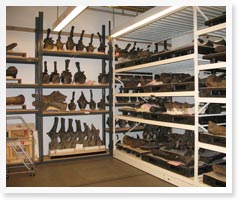Storage Furniture
A collection of any significant size will require some dedicated space for housing. With specimens ranging from millimeters in size to several tons, no one storage system will be appropriate for large collections and a combination of collections furniture such as racks, cabinets and pallets may be necessary.
Various issues need to be taken into account when selecting furniture for paleontology collections. Weight is an important consideration when housing fossils – a drawer of specimens may weigh as much as 20 lbs. You should consider the vulnerability of the collection to the various “Agents of Deterioration” that affect natural history collections, including fire, flood, theft, pests, light, and incorrect temperature and relative humidity. You may need to ensure that your new storage furniture is interchangeable with pre-existing collection housing, such as drawers, And, of course, your eventual solution will probably be dictated by budget limitations, or by space restrictions.
There is a wide range of storage solutions available for collections and it is beyond the scope of this site to discuss them all. The following are some general comments; the links at the end of this section will allow you to explore these issues in more detail.
Cabinets
Specimen cabinets are probably the most common form of collection storage. The main purpose of a specimen cabinet is to protect the specimens from the harmful effects of dust, light, and insect pests; from theft; and from unnecessary handling. Cabinets can be either stationary or (if the load bearing limits of the flooring and collection building allow) mounted on rails (compactors) to save space. Specialist museum cabinetry is usually made from steel and offers features such as lockable gasketed doors, which form an airtight seal when the cabinet is closed, and a powder-coated paint finish which is resistant to changes in RH and does not off-gas pollutants. They may have a built-in leveling system, to cope with uneven floors, and raised bases to reduce the risk of flood damage and remove shelter for pests. They are generally to order by one of a limited number of suppliers, and as a result are relatively expensive. However, they have a lifetime which can be measured in decades and represent a good long-term investment for the well-being of the collection.

The older generation of specimen cabinets was often wooden, and it’s not uncommon for many collections to re-use old wooden drawers in modern steel cabinets. Wood offers some advantages for collection storage, because it responds to changes in RH and can buffer specimens against fluctuations in the environment. However, this can also lead to drawers “sticking” in their tracks in conditions of raised RH; forcing drawers can lead to unnecessary vibration for fragile specimens. Some wood products will off-gas, which could have a negatively impact.
Racks
Bulk storage racks are particularly useful for housing medium- to large-sized specimens and field jackets that may not fit into a specimen cabinet, or may be too heavy to place in a drawer. As with cabinets, they can be static or mounted on compactors. They can have metal, plywood, or wire mesh decking that can be sealed and padded. Open shelving provides less security and protection than a specimen cabinet. However, polyethylene sheeting can be hung from the top of the rack to provide protection against dust buildup.
The main advantage of open racking is that it makes it easier to handle large, heavy, or unwieldy specimens. For this reason, it is important that the rack is positioned for maximum accessibility; it should be accessible from both sides and there should be sufficient aisle space between racks to allow for a ladder or fork-lift to be brought alongside the shelving.
Heavy duty storage racks, often rated at 2,000 lbs or more per shelf, are commonly used in commercial and industrial settings and can purchased comparatively cheaply.
 Lightweight bulk storage racks |  Heavy-duty bulk storage racks | |
 Medium-duty bulk storage racks |  Compactor-mounted storage racks |
Pallets
Moving the largest specimens, which may weigh hundreds of pounds, may require a pallet jack or fork-lift. To assist with this, the specimens should be placed on pallets, which can be placed at floor level or mounted on storage racks. In placing the pallets, it is important to allow sufficient space to maneuver either a lift of jack.
 Pallets housed under storage rack |



